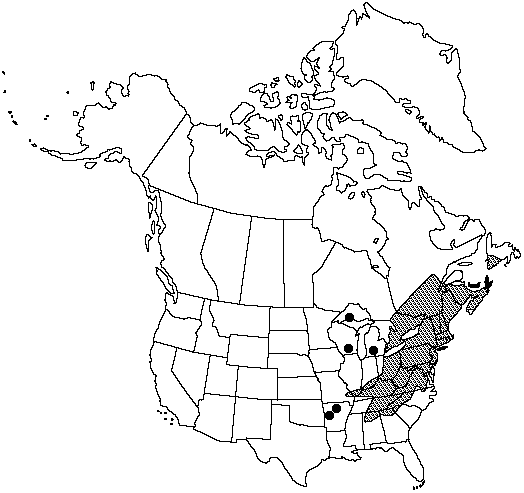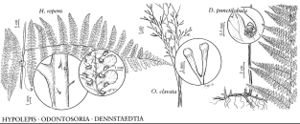Dennstaedtia punctilobula
Index Fil. 97. 1857.
Stems long-creeping, 2–3 mm diam. Leaves clustered, erect, 0.4–1(–1.3) × 0.1–0.3 m. Petiole straw-colored to brown, darker at base, dull, ca. 1/2 length of blade, pubescent with soft, jointed hairs. Blade yellow-green or pale green, dull, lanceolate, 2-pinnate-pinnatifid, ca. 3 times as long as wide, base slightly narrowed but truncate, apex acuminate, with soft, silver-gray, jointed hairs on both surfaces. Basal segments of pinnules opposite; ultimate segments ovate to lanceolate, base equilateral, truncate, margins deeply lobed, serrate-crenate. Sori globose to almost cylindric; indusia tubular to cylindric. Spores trilete, globose with low, tuberculate, distal face and equatorial flange. 2n = 68.
Phenology: Sporulates in summer.
Habitat: Rocky slopes, meadows, woods, stream banks, and roadsides, in acid soils
Elevation: 0–1200 m
Distribution

N.B., Nfld. and Labr. (Nfld.), N.S., Ont., P.E.I., Que., Ala., Ark., Conn., Del., Ga., Ill., Ind., Ky., Maine, Md., Mass., Mich., Mo., N.H., N.J., N.Y., N.C., Ohio, Pa., R.I., S.C., Tenn., Vt., Va., W.Va., Wis.
Discussion
Reports of occurrences of Dennstaedtia punctilobula in Iowa are based on incorrectly labeled specimens collected in Massachusetts (T. S. Cooperrider 1968). Dennstaedtia punctilobula spreads aggressively in open woods and clearings.
Selected References
None.
